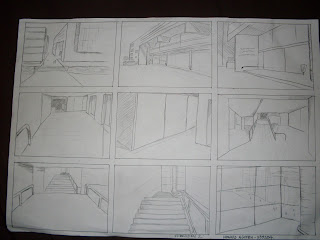Images of the completed final model.
Image 1.
Image 2.
Lower section
The theme for the lower section was 'conflicting'. Thus when designing the lower section. I used a flat base for the floor, a spiking roof for the top and a surround curved wall. The wall, floor and roof are all conflicting against one another. Also, the roof is made to be transparent. This allows the building to have a strong presence of an under ground section. The transparent roof also provides a warping and conflicting persepctive when looking at it from differing angles and from either above ground of below ground.
Image 3.
The staircase from the lower to the ground section is a grand staircase. This is to emphasise the celebration and joy of the completion of the artwork by the artist. The grand staircase puts a focus on the artist which will appear at the top of the staircase and make his way down. Further emphasis is added towards the attention of the artist thought the angle of the walls. These walls are slightly angled such that the stair case is almost in a 'V shape' - where a large audience on the ground can congratulate and welcome the artist and his works.
Image 4.
Upper section
The upper section was based on 'simplicity'. This is emphasised by the use of circles and spheres in the upper section. I believe spheres to be the most simple shape. The design of this upper structure was to allow the artist working at the top a complete view of his surroundings from which he can draw inspiration from. The staircase from the ground to upper section is a spiralling stair case. The staircase leading the the top spirals around the circular shape with hollow rectangular prisms as the base. There are also hand rails and landings/platforms for safety.
Image 5.
Image of the interior space. with a circular/donut bench for work. The Malangi sculpture sits in the centre, a place where the artist can also draw inspiration from.
Image 6.
3 videos
Scene 1
Scene 2
Scene 3
Link to the Google Sketch up folder:
Note: Sorry I had issues uploading this to Google Warehouse, so I uploaded it to rapidshare instead.
http://rapidshare.com/files/454594959/Model1.7_finalmodelonly_ground.skp
3 videos
Scene 1
Scene 2
Scene 3
Link to the Google Sketch up folder:
Note: Sorry I had issues uploading this to Google Warehouse, so I uploaded it to rapidshare instead.
http://rapidshare.com/files/454594959/Model1.7_finalmodelonly_ground.skp
































